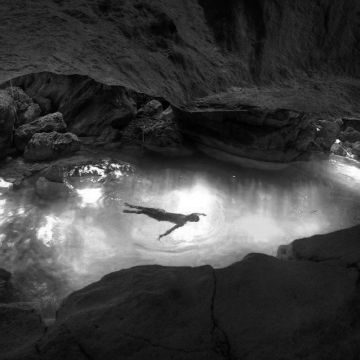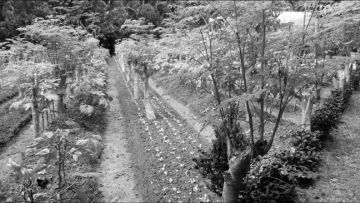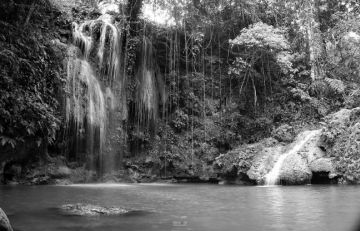
kanlaob River
When heading for Cebu’s southwest town of Alegria, what immediately comes to mind is canyoneering.
But there is actually so much to this tiny town whose name literally evokes joy.
One is the Salay Cave.
Very few had been paying attention to the cave, cocooned between the slopes of Alegria’s mountain villages, aside from some travel bloggers who have described its “ridiculously, tiny opening.”
But inside this cave, a handful of tourists managed to take photos, and share about the magnificent limestone formations hanging from its ceiling like chandeliers made out of marble. Some of them even called it as a haven of spelunking — a term coined to define the hobby of leisure cave explorations.
Reviews on Salay Cave had reached the local government of Alegria, who then realized that there is so much more their town can offer aside from canyoneering and their organic farms.
With a population of only 21,000, Alegria is a sleepy, seaside town in the southwestern portion of Cebu island, 115.8 kilometers from Cebu City. The serene and quiet Tañon Strait, its neighbor, is a reflection of the town’s peaceful environment.
The name Alegria is derived from the Spanish word alegre, which translates to cheerfulness and extravagant joy in English. Locals believed that Spaniards named it Alegria after uttering “Que alegria!” to describe how springs, tubod in Cebuano, sprout out of the mountains as if they were dancing to a certain tune.
Alegria Mayor Verna Magallon is now determined to bring the alegre back in her town with plans on boosting the potentials of several eco-tourist spots found in their place, including Salay Cave.
Last July 12, Magallon received P6 million from the Cebu provincial government to fund the town’s tourism industry, a much needed boost to its growing tourism potential.
The caves
There are actually two caves in Alegria – Cambusay and Salay, but it was the former which first gained popularity. In 2014, some tourists wound up to an unknown cave adjacent to Cambusay, thus the discovery of Salay.
The Department of Environment and Natural Resources in Central Visayas (DENR-7) issued an accreditation last 2015 that allowed the cave to become a tourism site, declaring it as a safe place to explore by spelunkers.
Now that Salay Cave has been getting enthusiastic reviews from those who have gone inside it, Magallon is determined to help spread the word.
With funds from the Capitol, she plans to launch a tourism campaign with the cave as the highlight.
“We’re going to maximize its potential to draw in more tourists,” Magallon said.

que alegre demo FARM
The falls
Alegria has five waterfalls – Cancalanog, Cambias, Kawa-Kawa, Montpeller and Kitara. Each one of them has gained steady popularity from local and foreign tourists.
But Magallon wants to pay more attention now to Cambias Falls not only because it is an underdog compared to the other four, but also the absence of an access road, which made it a difficult place to visit.
Cambias Falls is tucked in the hilly terrain of Barangay Guadalupe. One has to pay at least P50 for a motorcycle-driver-for-hire, or habal-habal, to get there.
But the motorcycle only stops at a small, wooden sign along the road which directs visitors to a dirt pathway that leads them to the waterfalls.
The mayor said she intended to transform this dirt pathway, which can get really muddy and perilous after a heavy downpour, into a more convenient, concrete road to attract more tourists to see the waterfalls’ pool of sparkling clear water turning to emerald-green.
Kanlaob River
The Kanlaob River, which is famous as the river route of the famous Badian-Alegria canyoneering event, ends in Barangay Compostela in Alegria town.
Canyoneering is a rare, extreme sport in the Philippines wherein canyoneerers hurl themselves to the river more than seven foot above the water’s surface.
Sometime in 2013, foreign tourists initially established a canyoneering area in Moalboal, a town 20 kilometers north of Alegria, but moved it to Badian in 2015 after they discovered a narrow but deep river hidden between two enormous cliffs, which offers a better canyoneering experience to enthusiasts.
Kanlaob River then became the famous canyoneering route. Canyoneerers enter the river in Badian town and exit in Alegria.
But for Magallon, the potential of Kanlaob has not yet been fully realized despite being recognized as a canyoneering destination.
“Kanlaob River (has a) great view… and to those who are not into canyoneering, I think it’s great if we can offer an alternative for them to visit Kanlaob without the intentions of diving into the waters,” she said.
In turn, she proposed to erect a boardwalk along Kanlaob River to give visitors, especially the middle-aged ones and senior citizens, a glimpse of its still, cerulean waters.
Magallon also plans to open up more souvenir shops as well as health centers in Barangay Compostela to complement the canyoneering services.

Cambias Falls
Que Alegre Farm
Another gem that sets Alegria apart from other towns in Cebu, and probably in the entire Central Visayas, is their local government’s initiative to teach residents the wonders of practicing a farm-to-table way of life.
But it became more than just a call for sustainable living.
Magallon turned her town’s farming practice into a tourism come on. It was so successful that it led to Alegria getting awarded as the Most Outstanding Organic Municipality in Central Visayas for the year 2016 by the regional office of the Department of Agriculture.
In addition, the Provincial Tourism Office saw the farming tourism’s uniqueness that it decided to include it in the PTO’s community-based, eco-tourism campaign titled “The Big 5,” which highlights the Top 5 tourist destinations in south Cebu.
The Big 5 is expected to be launched in August this year.
“Because of the laboratory on organic farming we set up, farmers both from Alegria and other municipalities will visit here with the intentions to learn more about it,” she said.
The demo-laboratory of Alegria’s organic farming, called as Que Alegre, is situated in Barangay Poblacion, Alegria.
The little over half a hectare demo farm prides itself on providing organically produced vegetables such as string beans, turmeric, malunggay and organically raised livestock, such as hogs and chickens, and freshwater fish.
Que Alegre’s chief caretaker, Frank Dasillo, revealed that their demo farm laboratory utilizes native microorganisms from animal wastes and decomposed produce as fertilizers, a technology originating from South Korea.
Inside the farm is a concrete pen, about three feet deep, and filled with dead leaves, rotten fruits and inedible vegetables. Wastes collected from the animals around the farm are dumped in here, too.
Dasillo buries the stench with shovelfuls of soil and another load of dead leaves. Then he releases a sack of African nightcrawlers on top of everything. African nightcrawler is a species of earthworm which farmers in South Korea and Japan used to help fertilize their soil.
African nightcrawlers, unlike ordinary earthworms, feed on animal waste and decomposing wastes which when digested and excreted from their bodies, are turned into fertilized soil.
The Que Alegre Farm began to supply livestock meat to big supermarkets in the towns of southern Cebu last year.
Now that additional funds are being poured into their tourism, Magallon expressed confidence that they can supply supermarkets in Metro Cebu before 2017 ends.
Disclaimer: The comments uploaded on this site do not necessarily represent or reflect the views of management and owner of Cebudailynews. We reserve the right to exclude comments that we deem to be inconsistent with our editorial standards.
